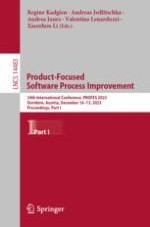This book constitutes the refereed proceedings of the 24th International Conference on Product-Focused Software Process Improvement, PROFES 2023, which took place in Dornbirn, Austria, in December 2023.
The 21 full technical papers, 8 short papers, and 1 poster paper presented in this volume were carefully reviewed and selected from 82 submissions. The book also contains one tutorial paper, 12 and workshop papers and 3 doctoral symposium papers.
The contributions were organized in topical sections as follows:
Part I: Software development and project management; machine learning and data science; software analysis and tools; software testing and quality assurance; security, vulnerabilities, and human factors;
Part II: Posters; Tutorials; 2nd Workshop on Computational Intelligence and Software Engineering (CISE 2023); 2nd Workshop on Engineering Processes and Practices for Quantum Software (PPQS’ 23); doctoral symposium.
